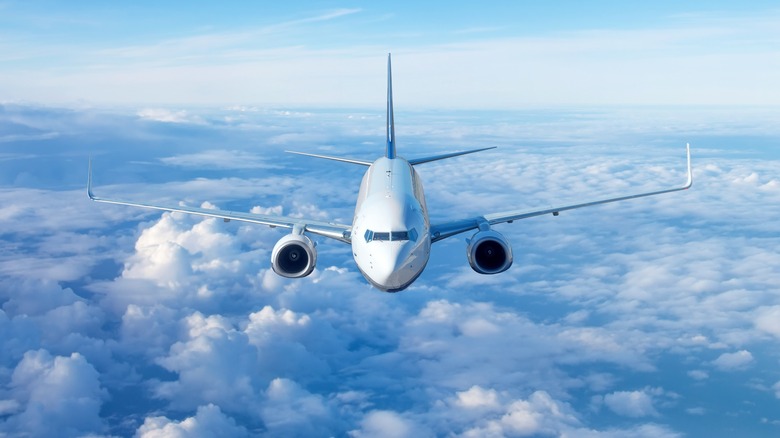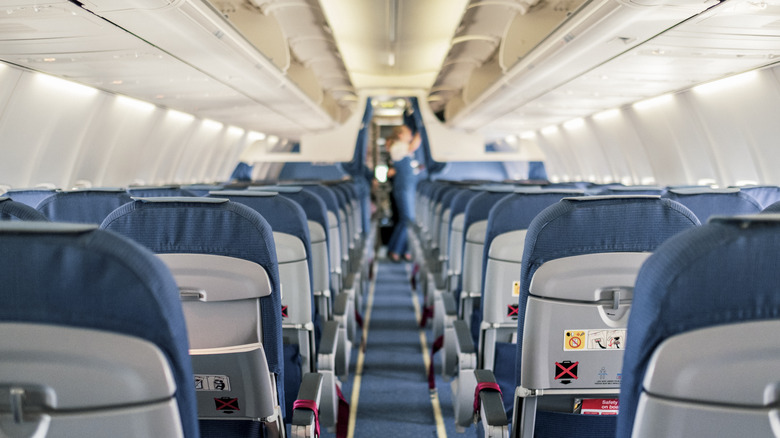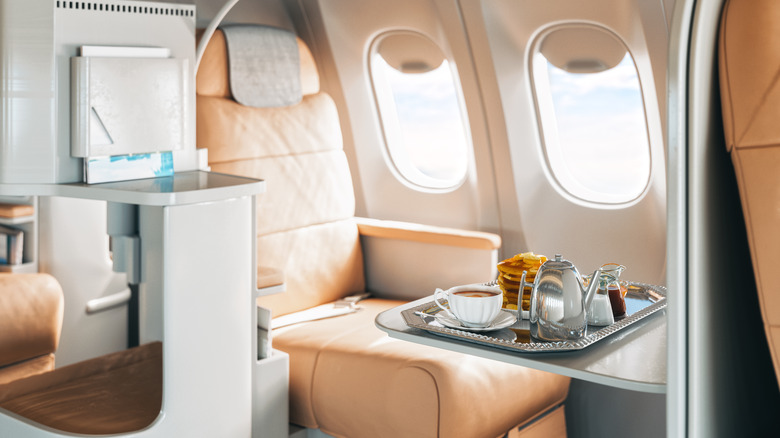Here's Why Airplanes Are So Similar To Those Built Over Half A Century Ago
As time goes on, things change, and it's usually for the better. Look at computer technology, for example. A computer used to take up an entire room. Now it can fit on a person's lap or even in their pocket. The storage capacity of a flash drive is significantly larger than it was just 20 years ago. Cars are light years ahead from where they started. Not passenger planes, though. With the exception of a little less legroom on a passenger airline, unless you're sitting in First Class, the design of airlines hasn't changed much.
Passengers still have to struggle down a narrow aisle to get to their cramped seat, where they typically have to fight like their life depended on it just to fit luggage in the overhead compartment. Bathroom space isn't much better either. Sure, First Class looks a little different and there are slight improvements, such as little TV screens in the seat backs, but the cabin of a passenger airplane today isn't much different from some of the forgotten airlines that once soared the skies.
One might ask themselves why innovation for airline cabins has been overwhelmingly stagnate. There are a couple of reasons, but it all boils down to money. Airline companies have had to focus their attention on other aspects of the airplane, pushing cabin design to the bottom of the list.
Where is the money going?
The once iconic Pan Am had bars and lounges on its planes for passengers to enjoy. Its passengers flew in comfort. Now, travelers have a hard time finding comfort on an airline unless it's in first class. Airlines have reduced the amount of legroom in favor of squeezing in more seating to cram more passengers on a flight. The majority of airline companies flying today focus their investment on the overall weight of the plane rather than interior design. Planes have always needed to be made out of something light in order to get off the ground, but metal quickly became a requirement to withstand the speeds of jet-powered flights. Aluminum and titanium were the metals of choice for some time. However, now metal is taking a back seat to carbon fiber-reinforced plastic composites.
Composites might be more expensive than pure metal, but they're also lighter than aluminum and don't corrode. Aerospace companies like Boeing are looking at polymers and ceramics to include in the construction of airplanes, which are lighter and just as strong as metal and composites. In a world where sustainability and green energy are a priority, lighter materials are helpful because they improve a plane's fuel efficiency. On top of that, airlines have been spending large sums of money on outfitting their planes with lean-burn engines, saving money on fuel, which is an airline's number one expenditure.
The future of airline design
Luckily, there is some innovation on the horizon. Tastes evolve but more importantly, certain trips demand different accommodations. People sitting upright for a brief four-hour flight is perfectly acceptable. When flying over the Atlantic from New York City to London, however, seating arrangements need a slight adjustment. As early as September 2024, Air New Zealand is introducing its "Skynest" concept to its Boeing 787 jets. The "Skynest" is a set of six bunk beds that will be in economy class, giving travelers a more comfortable experience during their long flights.
The German airliner Lufthansa is looking to crack more than just the airplane boarding problem. It's also updating its long-haul flights, giving passengers in economy, premium economy, business, and first class a choice of 14 different seat types. These seats range from actual beds with closeable doors for privacy to adjustable seats that don't impact travelers seated behind. David Caon, an airline cabin designer, is hard at work designing a revolutionary cabin for the Australian airline company, Qantas, with a welcoming homey feel to it.
His goal, he told The Telegraph, has been to create a cabin where travelers look and feel like they're at home, designing a cabin without overhead compartments in favor of seat-side storage. Better yet is the stretching and exercise area economy passengers will be able to take advantage of thanks to Caon removing 12 seats. When more seats aren't being squeezed in, passengers can be significantly more comfortable.


